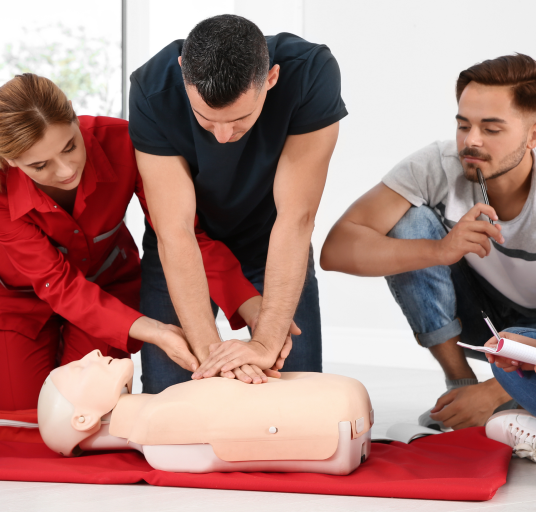Step-by-Step Chest Compressions for Adults : Chapter 4
Before beginning CPR, follow these initial steps:
-
- **Check the scene for your safety and prepare to use any personal protective equipment that may be accessible.
- Check to see if the patient is breathinge. Tap and shout, “Are you okay?” to see if victim is responsive. If unresponsive, continue with steps below.
- Occasional gasps, or agonal respirations, are not normal breathing.
- Activate EMS by calling 9-1-1 or send someone to call 9-1-1 if available. Get an AED if available.
- Check the victim’s pulse Don’t take more than 10 seconds to check for the pulse. Begin CPR if you cannot locate or are unsure of a pulse.
- For an adult and child check the carotid artery located in the neck. For an infant’s pulse check the brachial artery, which is located on the inside of the upper arm.
** Note: [2020 Interim Guidance] During COVID-19, many lay responders are unlikely to have access to adequate PPE. Use a face mask or cloth to cover your, and the victim’s, mouth and nose to prevent transmission.
Chest Compression Steps for an Adult:
*Note: For CPR emergencies, an adult is anyone who is going through or gone through puberty.
-
-
- Place yourself at the victim’s side.
- 2. Ensure that the victim is lying on his back on a firm, flat surface
- If unconscious and face down, roll the victim face-up while supporting the head, neck and back.
- Immediately remove clothes from the chest.
- Form the correct hand position for chest compressions:
- Place the heel of your hand on the breastbone, between the nipples.
- Place the other hand on top of the first hand and interlace the fingers.
- Keep the fingers off the chest.
- To form the correct body position for CPR: kneel down, and keep your arms straight above the chest and your shoulders above your hands. Lock your elbows.
- Compress / push down hard and fast at least 2 inches, but no more than 2.4 inches deep, at a rate of at least 100 to 120 compressions per minute.
- Make sure the chest rises back up completely after each compression.
2 Rescuer Technique – When a second rescuer is available to help:
-
-
-
- Let the second rescuer activate the Emergency Response System (call 9-1-1) and get the AED.
- The first rescuer should stay with the victim and be prepared to remove clothes from the chest and start CPR.
- When both rescuers are present with the victim, they should take turns doing chest compressions; switching approximately every 2 minutes. The rescuers should remind each other to push down at least 2 inches but no more than 2.4 inches deep, and watch for proper chest recoil.
